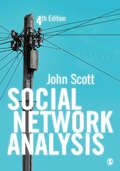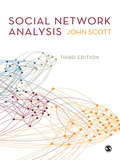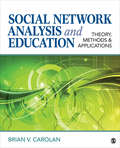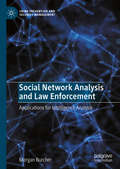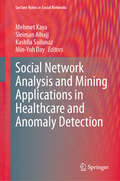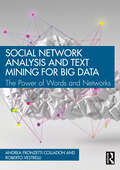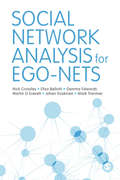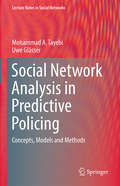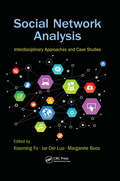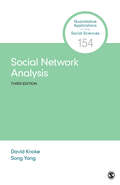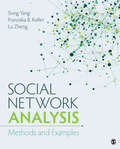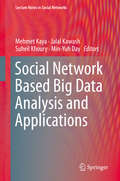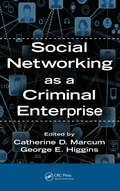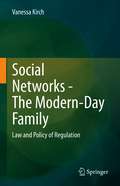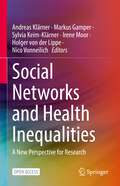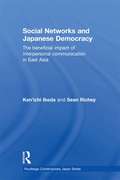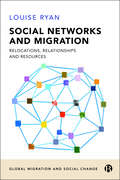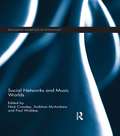- Table View
- List View
Social Network Analysis
by Professor John ScottIncorporating the most important and cutting-edge developments in the field, this bestselling text introduces newcomers to the key theories and techniques of social network analysis and guides more experienced analysts in their own research. New to This Edition: A chapter on data collection, covering a crucial phase of the research process Fully updated examples reiterate the continued importance of social network analysis in an increasingly interconnected world Detailed ‘Further Reading’ sections help you explore the wider literature Practical exercises including real-world examples of social networks enable you to apply your learning Expanded and brought right up-to-date, this classic text remains the indispensable guide to social network analysis for students, lecturers and researchers throughout the social sciences.
Social Network Analysis (Third Edition)
by John ScottThe Third Edition of this best-selling text has been fully revised and updated to include coverage of the many developments on social network analysis (SNA) over the last decade. Written in a clear and accessible style, the book introduces these topics to newcomers and non-specialists and gives sufficient detail for more advanced users of social network analysis. Throughout the book, key ideas are discussed in relation to the principal software programs available for SNA. The book provides a comprehensive overview of the field, outlining both its theoretical basis and its key techniques. Drawing from the core ideas of points, lines and paths, John Scott builds a framework of network analysis that covers such measures as density, centrality, clustering, centralisation, and spatialisation. He identifies the various types of clique, component, and circle into which networks are formed, and he outlines an approach to socially structured positions within networks. A completely new chapter in this edition discusses recent work on network dynamics and methods for studying change over time. A final chapter discusses approaches to network visualisation. This is an excellent resource for researchers across the social sciences and for students of social theory and research methods.
Social Network Analysis and Education: Theory, Methods & Applications
by Brian V. CarolanSocial Network Analysis and Education: Theory, Methods & Applications provides an introduction to the theories, methods, and applications that constitute the social network perspective. Unlike more general texts, this applied title is designed for those current and aspiring educational researchers learning how to study, conceptualize, and analyze social networks. Brian V. Carolan's main intent is to encourage you to consider the social network perspective in light of your emerging research interests and evaluate how well this perspective illuminates the social complexities surrounding educational phenomena. Relying on diverse examples drawn from the educational research literature, this book makes explicit how the theories and methods associated with social network analysis can be used to better describe and explain the social complexities surrounding varied educational phenomena.
Social Network Analysis and Law Enforcement: Applications for Intelligence Analysis (Crime Prevention and Security Management)
by Morgan BurcherThis book examines the use of social network analysis (SNA) in operational environments from the perspective of those who actually apply it. A rapidly growing body of literature suggests that SNA can reveal significant insights into the overall structure of criminal networks as well as the position of critical actors within such groups. This book draws on the existing SNA and intelligence literature, as well as qualitative interviews with crime intelligence analysts from two Australian state law enforcement agencies to understand its use by law enforcement agencies and the extent to which it can be used in practice. It includes a discussion of the challenges that analysts face when attempting to apply various network analysis techniques to criminal networks. Overall, it advances SNA as an investigative tool, and provides a significant contribution to the field that will be of interest to both researchers and practitioners interested in social network analysis, intelligence analysis and law enforcement.
Social Network Analysis and Mining Applications in Healthcare and Anomaly Detection (Lecture Notes in Social Networks)
by Mehmet Kaya Min-Yuh Day Sleiman Alhajj Kashfia SailunazThis book is an excellent source of knowledge for readers interested in the latest developments in social network analysis and mining, particularly with applications in healthcare and anomaly detection. It covers topics such as sensitivity to noise in features, enhancing fraud detection in financial systems, measuring the echo-chamber phenomenon, detecting comorbidity, and evaluating the effectiveness of mitigative and preventative actions on viral spread in small communities using agent-based stochastic simulations. Additionally, it discusses predicting behavior, measuring and identifying influence, analyzing the impact of COVID-19 on various social aspects, and using UNet for handling various skin conditions. This book helps readers develop their own perspectives on adapting social network concepts to various applications. It also demonstrates how to use various machine learning techniques for tackling challenges in social network analysis and mining.
Social Network Analysis and Text Mining for Big Data: The Power of Words and Networks
by Andrea Fronzetti Colladon Roberto VestrelliSocial Network Analysis and Text Mining for Big Data presents cutting-edge methods and tools that bridge the gap between text mining and social network analysis research while also providing new insights for analyzing (big) textual and network data. These tools are designed to cater to the needs of both business analysts and researchers to facilitate the creation of groundbreaking analytics.Beginning with clear definitions of social network analysis and text mining, this book benefits from a thoughtfully curated selection of methods and tools, drawn from the authors’ extensive research in the field. The focus then shifts to demonstrate how the interplay between words and networks can unlock the full potential of big data analytics. A centerpiece of the book is the Semantic Brand Score (SBS), a versatile and powerful metric for assessing brand importance through text analysis. All of the above is corroborated and illustrated with practical applications and case studies showing the value of these analytics in supporting change and improved managerial decisions. It also introduces a specialized software tool which enables users to perform the analyses detailed in the text.This book is a must-read for business leaders, marketing professionals, policymakers, researchers, and university students. It offers practical insights and actionable advice for achieving increased performance of companies and societal actions. The writing is tailored to make complex concepts accessible to both experienced researchers and readers who are new to the field.
Social Network Analysis for Ego-Nets: Social Network Analysis for Actor-Centred Networks
by Martin G. Everett Nick Crossley Elisa Bellotti Dr Johan Koskinen Dr Gemma Edwards Dr Mark TranmerThe ego-net approach to social network analysis, which takes discrete individual actors and their contacts as its starting point, is one of the most widely used approaches in the field. This is the first textbook to take readers through each stage of ego-net research, from conception, through research design and data gathering to analysis. It starts with the basics, assuming no prior knowledge of social network analysis, but then moves on to introduce cutting edge innovations, covering both new statistical approaches to ego-net analysis and also the most recent thinking on mixing methods (quantitative and qualitative) to achieve depth and rigour. It is an absolute must for anybody wishing to explore the importance of networks.
Social Network Analysis for Ego-Nets: Social Network Analysis for Actor-Centred Networks
by Martin G. Everett Nick Crossley Elisa Bellotti Dr Johan Koskinen Dr Gemma Edwards Dr Mark TranmerThe ego-net approach to social network analysis, which takes discrete individual actors and their contacts as its starting point, is one of the most widely used approaches in the field. This is the first textbook to take readers through each stage of ego-net research, from conception, through research design and data gathering to analysis. It starts with the basics, assuming no prior knowledge of social network analysis, but then moves on to introduce cutting edge innovations, covering both new statistical approaches to ego-net analysis and also the most recent thinking on mixing methods (quantitative and qualitative) to achieve depth and rigour. It is an absolute must for anybody wishing to explore the importance of networks.
Social Network Analysis in Predictive Policing
by Mohammad A. Tayebi Uwe GlässerThis book focuses on applications of social network analysis in predictive policing. Data science is used to identify potential criminal activity by analyzing the relationships between offenders to fully understand criminal collaboration patterns. Co-offending networks--networks of offenders who have committed crimes together--have long been recognized by law enforcement and intelligence agencies as a major factor in the design of crime prevention and intervention strategies. Despite the importance of co-offending network analysis for public safety, computational methods for analyzing large-scale criminal networks are rather premature. This book extensively and systematically studies co-offending network analysis as effective tool for predictive policing. The formal representation of criminological concepts presented here allow computer scientists to think about algorithmic and computational solutions to problems long discussed in the criminology literature. For each of the studied problems, we start with well-founded concepts and theories in criminology, then propose a computational method and finally provide a thorough experimental evaluation, along with a discussion of the results. In this way, the reader will be able to study the complete process of solving real-world multidisciplinary problems.
Social Network Analysis: Interdisciplinary Approaches and Case Studies
by Xiaoming Fu; Jar-Der Luo; Margarete BoosThe book addresses the issue of interdisciplinary understanding of collaboration on the topic of social network studies. Researchers and practitioners from various disciplines including sociology, computer science, socio-psychology, public health, complex systems, and management science have worked largely independently, each with quite different principles, terminologies, theories. and methodologies. The book aims to fill the gap among these disciplines with a number of the latest interdisciplinary collaboration studies.
Social Network Analysis: Methods And Examples (Quantitative Applications in the Social Sciences #154)
by David Knoke Song YangDavid Knoke and Song Yang′s Social Network Analysis, Third Edition provides a concise introduction to the concepts and tools of social network analysis. The authors convey key material while at the same time minimizing technical complexities. The examples are simple: sets of 5 or 6 entities such as individuals, positions in a hierarchy, political offices, and nation-states, and the relations between them include friendship, communication, supervision, donations, and trade. The new edition reflects developments and changes in practice over the past decade. The authors also describe important recent developments in network analysis, especially in the fifth chapter. Exponential random graph models (ERGMs) are a prime example: when the second edition was published, P* models were the recommended approach for this, but they have been replaced by ERGMs. Finally, throughout the volume, the authors comment on the challenges and opportunities offered by internet and social media data.
Social Network Analysis: Methods And Examples (Quantitative Applications in the Social Sciences #154)
by David Knoke Song YangDavid Knoke and Song Yang′s Social Network Analysis, Third Edition provides a concise introduction to the concepts and tools of social network analysis. The authors convey key material while at the same time minimizing technical complexities. The examples are simple: sets of 5 or 6 entities such as individuals, positions in a hierarchy, political offices, and nation-states, and the relations between them include friendship, communication, supervision, donations, and trade. The new edition reflects developments and changes in practice over the past decade. The authors also describe important recent developments in network analysis, especially in the fifth chapter. Exponential random graph models (ERGMs) are a prime example: when the second edition was published, P* models were the recommended approach for this, but they have been replaced by ERGMs. Finally, throughout the volume, the authors comment on the challenges and opportunities offered by internet and social media data.
Social Network Analysis: Methods and Applications
by Stanley Wasserman Katherine FaustSocial network analysis, which focuses on relationships among social entities, is used widely in the social and behavioral sciences, as well as in economics, marketing, and industrial engineering. Social Network Analysis: Methods and Applications reviews and discusses methods for the analysis of social networks with a focus on applications of these methods to many substantive examples. As the first book to provide a comprehensive coverage of the methodology and applications of the field, this study is both a reference book and a textbook.
Social Network Analysis: Methods and Examples (Quantitative Applications In The Social Sciences Ser. #154)
by Lu Zheng Song Yang Franziska B KellerSocial Network Analysis: Methods and Examples prepares social science students to conduct their own social network analysis (SNA) by covering basic methodological tools along with illustrative examples from various fields. This innovative book takes a conceptual rather than a mathematical approach as it discusses the connection between what SNA methods have to offer and how those methods are used in research design, data collection, and analysis. Four substantive applications chapters provide examples from politics, work and organizations, mental and physical health, and crime and terrorism studies.
Social Network Analysis: Methods and Examples (Quantitative Applications In The Social Sciences Ser. #154)
by Lu Zheng Song Yang Franziska B KellerSocial Network Analysis: Methods and Examples prepares social science students to conduct their own social network analysis (SNA) by covering basic methodological tools along with illustrative examples from various fields. This innovative book takes a conceptual rather than a mathematical approach as it discusses the connection between what SNA methods have to offer and how those methods are used in research design, data collection, and analysis. Four substantive applications chapters provide examples from politics, work and organizations, mental and physical health, and crime and terrorism studies.
Social Network Based Big Data Analysis and Applications (Lecture Notes In Social Networks Ser.)
by Suheil Khoury Jalal Kawash Mehmet Kaya Min-Yuh DayThis book is a timely collection of chapters that present the state of the art within the analysis and application of big data. Working within the broader context of big data, this text focuses on the hot topics of social network modelling and analysis such as online dating recommendations, hiring practices, and subscription-type prediction in mobile phone services. Manuscripts are expanded versions of the best papers presented at the IEEE/ACM International Conference on Advances in Social Networks Analysis and Mining (ASONAM’2016), which was held in August 2016. The papers were among the best featured at the meeting and were then improved and extended substantially. Social Network Based Big Data Analysis and Applications will appeal to students and researchers in the field.
Social Networking as a Criminal Enterprise
by George E. Higgins Catherine D. MarcumAs social networking continues to evolve and expand, the opportunities for deviant and criminal behavior have multiplied. Social Networking as a Criminal Enterprise explores how new avenues for social networking criminality have affected our criminal justice system.With insight from field experts, this book examines:The history of social networking
Social Networks - The Modern-Day Family: Law and Policy of Regulation
by Vanessa KirchSocial networks have created a plethora of problems regarding privacy and the protection of personal data. The use of social networks has become a key concern of legal scholars, policy-makers and the operators as well as users of those social networks. This pathbreaking book highlights the importance of privacy in the context of today's new electronic communication technologies as it presents conflicting claims to protect national and international security, the freedom of the Internet and economic considerations. Using the New Haven School of Jurisprudence's intellectual framework, the author presents the applicable law on privacy and social media in international and comparative perspective, focusing on the United States, the European Union and its General Data Protection Regulation of 2018 as well as Germany, the United Kingdom and Latin America. The book appraises the law in place, discusses alternatives and presents recommendations in pursuit of a public order of human dignity.
Social Networks and Food Security in the Urban Fringe (GeoJournal Library)
by Stephen Morse The Reverend MacNamaraThis book explores how social groups in the urban fringe of Abuja, Nigeria, engaged with a series of development projects spanning 15 years (2003 to 2018) which focused on the enhancement of food security for farming households. The groups were at the heart of these development projects and the book presents the many insights that were gained by farmers and project agents working within these partnerships and provides advice for those seeking to do the same. The book also explores how the social groups attempted to lever benefits from being near to the fastest growing city in Africa and a centre of economic and political power. While much has been written about social groups and their embeddedness within wider social networks in Africa and in other parts of the world, the exploration of the role of social groups within development projects is an area that remains relatively unchartered and this book seeks to fill that important gap in knowledge. It provides an important contribution for all those researching and working with social groups in the developing world.
Social Networks and Health Inequalities: A New Perspective for Research
by Andreas Klärner Markus Gamper Sylvia Keim-Klärner Irene Moor Holger von der Lippe Nico VonneilichThis open access book applies insights from the network perspective in health research to explain the reproduction of health inequalities. It discusses the extant literature in this field that strongly correlates differences in social status with health behaviours and outcomes, and add to this literature by providing a coherent theoretical explanation for the causes of these health inequalities. It also shows that much research is needed on the precise factors and the social and socio-psychological mechanisms that are at play in creating and cementing social inequalities in health behaviours. While social support and social relations have received considerable attention within social and behavioural science research on health inequalities, this book considers the whole network of interpersonal relations, structures and influence mechanisms. This is the perspective of the social network analytical approach which has recently gained much attention in health research. The chapters of this book cover state-of-the-art research, open research questions, and perspectives for future research. The book provides network analyses on health inequalities from the perspective of sociology, psychology, and public health and is of interest to a wide range of scholars, students and practitioners trying to understand how health inequalities are reproduced across generations.
Social Networks and Japanese Democracy: The Beneficial Impact of Interpersonal Communication in East Asia (Routledge Contemporary Japan Series)
by Sean Richey Ken'ichi IkedaMany who critique democracy as practiced in East Asia suggest that the Confucian political culture of these nations prevents democracy from being the robust participatory type, and limits it to a spectacle designed to create obedience from the public. Certainly some East Asian nations have had elections for decades, but for democracy to be meaningful, a country needs an active public sphere, political tolerance, egalitarian beliefs, and vigorous political participation. The Asian-values debate focuses on whether the creation of this optimal version of democracy in East Asian nations will be hindered by their shared Confucian cultural heritage and at the centre of this debate is whether there is an active political culture in East Asia that allows citizens to freely discuss, debate, and disagree about politics. With Japan as its focus, this book examines the role of social networks and political discussion in Japanese political culture and asks whether discursive participatory democracy is indeed possible in East Asia. In order to answer this question the authors undertook the largest academic political survey ever conducted in Japan to give the book exceptional empirical credence. This data reveals how the Japanese people interact politically, concluding that through the powerful influence of social networks on Japanese political behaviour, Japan has a more globalized and less hierarchical society where Confucian culture is not dominant and where creation of a vibrant civil society is possible. This book will be invaluable for students and scholars of Japanese politics, democracy, civil society, and globalization.
Social Networks and Migration: Relocations, Relationships and Resources (Global Migration and Social Change)
by Louise RyanLeading migration researcher Louise Ryan’s topical and intersectional book provides rich insights into migrants’ social networks. It draws on more than 200 interviews with migrants who followed various transnational routes in every decade since the 1940s, in order to build valuable longitudinal perspectives and comparisons. With a particular focus on London, it charts how social networks are formed and sustained, how trust is developed and how social support is accessed, and explores the key opportunities and obstacles that migrants encounter. This is a seminal fusion of migration studies and social network analysis that casts new light on both subjects, essential for those interested in immigration, ethnicity, diversity and inequalities.
Social Networks and Music Worlds (Routledge Advances in Sociology)
by Nick Crossley Paul Widdop Siobhan McAndrewSocial networks are critical for the creation and consumption of music. This edited collection, Social Networks and Music Worlds, introduces students and scholars of music in society to the core concepts and tools of social network analysis. The collection showcases the use of these tools by sociologists, historians and musicologists, examining a variety of distinct 'music worlds', including post-punk, jazz, rap, folk, classical music, Ladyfest and the world of 'open mic' performances, on a number of different scales (local, national and international). In addition to their overarching Introduction, the editors offer a very clear and detailed introduction to the methodology of social network analysis for the uninitiated. The collection builds upon insights from canonic texts in the sociology of music, with the crucial innovation of examining musical network interaction via formal methods. With network analysis in the arts and humanities at an emergent stage, Social Networks and Music Worlds highlights its possibilities for non-scientists. Contributions hail from leading and emerging scholars who present social network graphs and data to represent different music worlds, locating individuals, resources and styles within them. The collection sits at the nexus of sociological, musicological and cultural studies traditions. Its range should ensure a large scholarly readership.
Social Networks and Natural Resource Management: Uncovering the Social Fabric of Environmental Governance
by Örjan Bodin Christina PrellSocial Network Analysis (SNA), a quantitative approach to the study of social relations, has recently emerged as a key tool for understanding the governance of natural resources. Bringing together contributions from a range of researchers in the field, this is the first book to fully explore the potential applications of SNA in the context of natural resource management. Topics covered include the role of SNA in stakeholder selection; improving fisheries management and conservation; the effect of social network ties on public satisfaction and agrarian communication networks. Numerous case studies link SNA concepts to the theories underlying natural resource governance, such as social learning, adaptive co-management and social movements theory. Reflecting on the challenges and opportunities associated with this evolving field, this is an ideal resource for students and researchers involved in many areas of natural resource management, environmental biology, sustainability science and sociology.
Social Networks and Regional Identity in Bronze Age Italy
by Emma Blake"This book takes an innovative approach to detecting regional groupings in peninsular Italy during the Late Bronze Age, a notoriously murky period of Italian prehistory. Applying social network analysis to the distributions of imports and other distinctive objects, Emma Blake reveals previously unrecognized exchange networks that are in some cases the precursors of the named peoples of the first millennium BC: the Etruscans, the Veneti, and others. In a series of regional case studies, she uses quantitative methods to both reconstruct and analyze the character of these early networks and posits that, through path dependence, the initial structure of the networks played a role in the success or failure of the groups occupying those same regions in later times. This book thus bridges the divide between Italian prehistory and the Classical period, and demonstrates that Italy's regionalism began far earlier than previously thought"--
